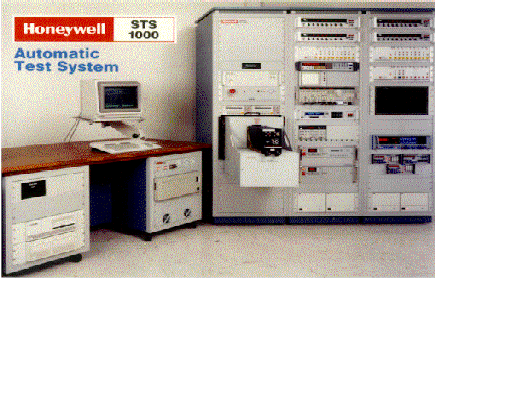
STS 1000 Unleashed

| A
leviathan
monster has been the butt of many a joke cracked on the
first floor. It is downright ugly, does not fit in the
interior decor and sucks in all the cool air the
airconditioner has to offer! In this age, where COM is
the guiding light and distributed processing the order of
the day, it is a throwback to the old primitive days of
computing, with a central repository having a mere 50MB
of memory, and a program size limitation of 32KB!! All it’s utilities communicate on the old and trusted IEEE-488 HPIB bus, under the control of an A-600 processor(ever heard of it? ) . Yet, the group swears by it. No effort to keep it up and running is too great for them, no jokes good enough to test their patience! To them, STS 1000 is more than a means of bread &butter, it’s a religion, a way of life. A peep into this amazing paradox throws to light some interesting facts. Ever heard of a Real Time OS which controls as many as 63 instruments? Which can run six different user sessions? Which is a multiprogramming OS? Well, if your thought process centered on QNX, I wouldn’t blame you. But it’s not QNX I’m talking about, it’s a relatively unknown, but highly rugged Operating System HP’s RTE-A, which takes the credit for this seemingly impossible task. That’s not all. What would you do if the utilities on this Operating System became obsolete and you have absolutely no documentation for the same? Don’t say that you’d buy a new system because that means investing something close to $600,000. And don’t say that you can do without it because that means that means you’d be putting your Avionics module into the aircraft without it having been tested on the ground!! So, finally exasperated you’d turn to the only possible answer, the one the STS 1000 team has to offer, one of emulating the utilities. For instance, replace the HP-1000’s touch sensitive screen, which is linked to the host over a COM port (before I forget, it’s not the COM of Microsoft Usage, it’s a communications port), with a PC and emulate the entire touch screen to the PC monitor. And that’s just what they did! A full fledged Terminal Emulation software for the HP-150A touch screen terminal was developed in a time frame of just six months! A peep into this wonderful world of ATE and the STS 1000 is given below by this bunch of die-hard optimists. On their shoulders rest the hopes of many an airline companies who want their STS 1000 stations to see the turn of the century---without them getting obsolete.
The STS Team Mani, Das, Narayana and Thantry (left to right) with the STS 1000. The other members are Shamal and Jaya
AUTOMATIC TEST EQUIPMENT (ATE) What is ATE ? Automated test equipment which is popularly known as ATE is Equipment designed to test the electronic components, modules, systems with the aid of a Computer as a controller. Classification of ATE’s: ATE’s can be broadly classified based on their use. 1. Component ATE’s: These ATE’s are basically used to test the electronic components for their specifications. They range from resistor checking to complex microchip testing ATE’s. Leading ATE manufacturers in this area are Terradyne, Dynapart etc. 2. Assembled PCB or Board Testing ATE’s: These are the type of ATE’s basically used to test the assembled component’s PCB’s. These types of ATE’s generally makes use of ‘Bed-Of-Nail’ fixtures for mounting the board or unit under test (UUT). They carry out tests by accessing each nodal point on the PCB where components are mounted. Schlumberger, Genrad, Terradyne, HP are few leading manufacturers of these type of ATE’s.
The UUT is connected to the Tester at its End connector and in many case the interface between the UUT and Tester is through a Fixture called Test Unit Adapter. The recent development in these kinds of ATEs are use of a special kind of communication interface called VXI bus. Here the instruments and controller are all minitiarised into PCB or cards and these are controlled by VXI bus. Thus the size of ATE’s have come down drastically and the speed of the operation has increased significantly. Now that you’ve the basic background of what an ATE is and what it does, it’s time you graduated to STS 1000. The STS-1000 is a system level ATE which consists entirely of instruments which are used for testing Line Replaceable Units (LRU’s) which ultimately go to the aircraft cockpit. A couple of well known LRU’s are the Mode Control Panel(MCP), the Flight Control Computer(FCC) and the Advanced Flight Manager Computer(AFMC), all of which can be tested on the STS 1000 Test station. The test cases, technically called the Test Program Sets (TPS) for these LRU’s are written in the ATLAS programming language which looks a bit like COBOL ! The STS-1000 is modular in design, instruments on the station can be replaced with little modification in the driver software and is controlled by a robust HP-1000 controller, which has the Real Time OS, RTE-A running on it. The test bed for running the TPS is the elegant Honeywell Proprietary application, the Test Executive. It manages the resources on the HP-1000, acts as an interface between the Operating System and the Application(the TPS) and provides a user interface to the unskilled operator. So, the next time the airconditioner doesn’t give you the cool air you expect, don’t fret or fume. Instead, think of the numerous test cases that the STS-1000 test station might be running, just to ensure that you get an accident free passage the next time you travel by air. |